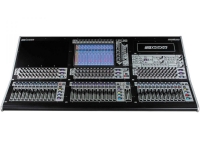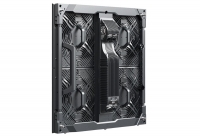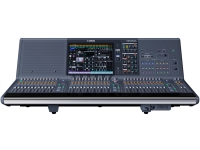ABOUT THE PRODUCT
ABOUT THE MANUFACTURER
GLOSSARY
SD8
Into overdrive and beyond...
The SD8 is a particularly versatile console with the same Stealth Digital Processing and floating point Super FPGA technology seen in the flagship SD7. The SD8 offers a truly superlative performance at a competitive price, something which will appeal to engineers across the board.
Scratching the surface
There are two versions of the SD8: a 37-channel version, which boasts three banks of 12 motorised faders and one master fader and the SD8-24, which has all the same power and functionality but in a smaller frame comprising 24 main channel faders and a master fader.
At the heart of each console`s worksurface is a 15-inch, high resolution TFT LCD touch screen with backlit display. Through this user-friendly interface, any bank of 12 faders can be instantly assigned as input or output channels, allowing all 36 main faders to control inputs if desired; equally, any bank of 12 can also be assigned to the touch screen for fine-tuning.
In addition, the SD8 benefits from dedicated multi-function control knobs and electronic labelling.
What`s under the hood?
Both SD8 models boast 120 input channels at 48kHz/96kHz. Standard channel processing, whether inputs or outputs, includes Channel Delay, Single and Multi Channel Presets, Dual insert points, Hi- and Lo-pass filters at 24dB/octave, four-band parametric EQ with band curve selection, DiGiCo`s DYN 1 (Compressor, De-esser or Multi Channel Compressor) and DYN 2 (Gate, Compressor or Ducker).
The console also benefits from 190 Dynamic EQ processors, all of which can be assigned to any of the input or output channels. These powerful processors offer dynamic processing on each of the four standard parametric bands, plus there are also 190 Multiband Compressors and 190 DiGiTubes and no matter how the console is set up, the user won`t lose any resources, as all the channels are equipped to provide the same high quality signal path and feature set.
The master section incorporates 24 gangable 32-band graphic EQs, 16 stereo effects (selectable from a palette of 33), and 24 control groups (VCAs); and using snapshots, engineers can now switch between complete configurations in any live environment easier than ever before, be it at rehearsals, during system setup, or even at a show.
In addition, we`ve included 48 busses, all of which are assignable as mono/stereo groups or auxiliary busses; and in addition to these busses, for further configurability, we`ve provided a 16 x 16 output matrix, dual solo busses, and a Master buss.
Unlike all other digital console manufacturers, you don`t lose Aux or Group Busses when using the Matrix as they are in addition, including the Master buss.
I/O
The SD8 and SD8-24 both have plenty of local I/O: eight mic inputs, eight outputs, eight mono AES I/O, and two MADI connections.
The console comes as standard with a D2 Rack which is an 8U fixed 48 input with eight analogue outputs, with the ability to increase these outputs to 24 with any combination of analogue AES/EBU or Aviom.
As with all DiGiCo consoles, it can also connect to an SD-Rack, an SD-Mini, and SD-Nano Rack or even a D rack.There is also a factory fit Optocore option which allows for connectivity to all DiGiCo racks and consoles in a redundant loop.
In addition, there is an optional DiGiCo SoundGrid module which, when linked to an external PC server such as SoundGrid or DiGiGrid, provides the user with instant access to 32 fully integrated low-latency Waves stereo Multi Racks, each with the ability to have up to eight plugins per rack. That`s 128 I/O - and as you`d expect from DiGiCo, this is all additional I/O.
All Waves compatible plugins are pre-loaded, and as this is integral within the console, you have the added advantage of touch screen control and all shapshots and session files are saved within the console.
Main Features
- 120 Input Channels
- 48 Aux / Sub-Group Busses
- LR/LCR/LCRS Master Bus
- 16x16 Full Processing Matrix
- 2 Solo
- 190 Dynamic Equalizers
- 190 DiGiTuBes
- 190 Multiband Compressors
- 16 Digital FX
- 24 Graphic Equalizers
- Optional Waves Integration
- 48/96 kHz Sample Rate
- Optional Factory fit only Optics
Professional used lighting equipment.| Professional second hand lighting equipment.| Professional pre owned lighting equipment.
Professional used audio equipment.| Professional second hand audio equipment.| Professional pre owned audio equipment.
Second hand audio gear. | Second hand lighting.
Pro audio equipment, second hand amplifiers, DJ, second hand sound systems, second hand Microphones, second hand Media Players.
Outdoor & Indoor LED screens for sale, LED mobile truck.
Light trussing, Gebrauchte Veranstaltungstechnik, used stage equipment Stage & Theatre lighting products.
Used DiGiCo
DiGiCo is a British company, founded in 2002, that manufactures digital mixing consoles targeted for live audio mixing applications.DiGiCo's most current console lineup comprises the SD-Series of consoles, powered by Stealth Digital Processing.
Pioneered with their flagship SD7, Stealth Digital Processing describes DiGiCo's first use of a single large scale FPGA for audio processing. Combined with Tiger SHARC DSP chips for effects processing and control, this new technology allows an entire audio engine to occupy only a single PCB.
The SD7 continues to be the flagship of the range, with consoles derived from it targeting other market areas and sizes of application. Currently the rest of the range comprises the SD5, SD10, SD8, SD9 and rack-mountable SD11, listed in order of size. T (Theatre) and B (Broadcast) software is also available for selected consoles.
The use of a flexible FPGA processing engine allows dedicated software to be written, to further refine the consoles features and operation for specific applications. The SD7, SD10 and SD9 are available with the optional theatre upgrade package, with the SD7, SD5, SD10, SD9 and SD11 having the option of a broadcast package.
Legacy DiGiCo consoles include the D1 and D5 Live platforms, as well as the D5T theatre console and DS00 studio production and broadcast console. The D-Series of consoles used a modular DSP engine, combining multiple SHARC DSP chips to form a large scale audio engine, still the method by which virtually all digital console manufacturers design their products.
Professional used lighting equipment.| Professional second hand lighting equipment.| Professional pre owned lighting equipment.
Professional used audio equipment.| Professional second hand audio equipment.| Professional pre owned audio equipment.
Second hand audio gear. | Second hand lighting.
Pro audio equipment, second hand amplifiers, DJ, second hand sound systems, second hand Microphones, second hand Media Players.
Outdoor & Indoor LED screens for sale, LED mobile truck.
Light trussing, Gebrauchte Veranstaltungstechnik, used stage equipment Stage & Theatre lighting products.
Active: Powered. An active crossover is electrically powered and divides the line-level signal prior to amplification. An active speaker includes an active crossover and built-in amplifier.
Actuality: Audio from an announcer speaking.
Amplifier: A component that increases the gain or level of an audio signal.
Balanced Input: A connection with three conductors: two identical signal conductors that are 180 degrees out of phase with each other, and one ground. This type of connection is very resistant to line noise.
Bandpass: A two-part filter that cuts both higher and lower frequencies around a center band. A bandpass enclosure cuts high frequencies by acoustic cancellation and low frequencies by natural physical limitations on bass response.
Bandwidth: In audio, the range of frequencies a device operates within. In video, the range of frequencies passed from the input to the output. Bandwidth can also refer to the transmission capacity of an electronic communications device or system the speed of data transfer,is very important when planning a meeting for the attendees to stay connected.
Bass: Low frequencies; those below approximately 200 Hz.
Bi-Wiring: A method of connecting an amplifier or receiver to a speaker in which separate wires are run between the amp and the woofer and the amp and the tweeter.
Boost: To increase, make louder or brighter; opposite of attenuate.
Bridging: Combining two channels of an amplifier to make one channel that more powerful. One channel amplifies the positive portion of an audio signal and the other channel amplifies the negative portion, which are then combined at the output.
CD: Compact Disc. Ubiquitous digital audio format. Uses 16-bit/44.1-kHz sampling rate PCM digital signal to encode roughly 74 or 80 minutes of two- channel, full-range audio onto a 5-inch disc.
CD-R: Recordable Compact Disc.
CD-RW: Rewritable Compact Disc.
Channel: In components and systems, a channel is a separate signal path. A four-channel amplifier has at least four separate inputs and four separate outputs.
Coloration: Any change in the character of sound (such as an overemphasis on certain tones) that reduces naturalness.
Crossover: A component that divides an audio signal into two or more ranges by frequency, sending, for example, low frequencies to one output and high frequencies to another. An active crossover is powered and divides the line-level audio signal prior to amplification. A passive crossover uses no external power supply and may be used either at line level or, more commonly, at speaker level to divide the signal after amplification and send the low frequencies to the woofer and the high frequencies to the tweeter.
Crossover Frequency: The frequency at which an audio signal is divided. 80 Hz is a typical subwoofer crossover point and is the recommended crossover point in theatrical and home THX systems. Frequencies below 80 Hz are sent to the subwoofer signals above 80 Hz are sent to the main speakers.
Cut: To reduce, lower; opposite of boost.
Decibel (dB): A logarithmic measurement unit that describes a sound`s relative loudness, though it can also be used to describe the relative difference between two power levels. A decibel is one tenth of a Bel. In sound, decibels generally measure a scale from 0 (the threshold of hearing) to 120-140 dB (the threshold of pain). A 3dB difference equates to a doubling of power. A 10dB difference is required to double the subjective volume. A 1dB difference over a broad frequency range is noticeable to most people, while a 0.2dB difference can affect the subjective impression of a sound.
Delay: The time difference between a sonic event and its perception at the listening position (sound traveling through space is delayed according to the distance it travels). People perceive spaciousness by the delay between the arrival of direct and reflected sound (larger spaces cause longer delays.
Diaphragm: The part of a dynamic loudspeaker attached to the voice coil that produces sound. It usually has the shape of a cone or dome.
Diffusion: In audio, the scattering of sound waves, reducing the sense of localization. In video, the scattering of light waves, reducing hot spotting, as in a diffusion screen.
Digital Audio Server: Essentially a hard drive, a digital audio server stores compressed audio files (like MP3 or WMA). Most include the processing to make the files, and all have the ability to play them back.
Direct-Stream Digital: A format for encoding high-resolution audio signals. It uses a 1-bit encoder with a sampling rate of 2,822,400 samples per second (verses 44,100 for CD). Used to encode six high-resolution channels on SACD.
Dispersion: The spread of sound over a wide area.
Distortion: Any undesired change in an audio signal between input and the output.
DNR: Dynamic Noise Reduction. A signal-processing circuit that attempts to reduce the level of high-frequency noise. Unlike Dolby NR, DNR doesn’t require preprocessing during recording.
Dolby B: A noise-reduction system that increases the level of high frequencies during recording and decreases them during playback.
Dolby C: An improvement on Dolby B that provides about twice as much noise reduction.
Dolby Digital: An encoding system that digitally compresses up to 5.1 discrete channels of audio (left front, center, right front, left surround, right surround, and LFE) into a single bitstream, which can be recorded onto a DVD, HDTV broadcast, or other form of digital media. When RF-modulated, it was included on some laser discs, which requires an RF-demodulator before the signal can be decoded. Five channels are full-range; the .1 channel is a band-limited LFE track. A Dolby Digital processor (found in most new receivers, preamps, and some DVD players) can decode this signal back into the 5.1 separate channels. Most films since 1992`s Batman Returns have been recorded in a 5.1 digital format, though a number of films before that had 6-channel analog tracks that have been remastered into 5.1.
Dolby EX: An enhancement to Dolby Digital that adds a surround back channel to 5.1 soundtracks. The sixth channel is matrixed from the left and right surround channels. Often referred to as 6.1. Sometimes referred to as 7.1 if the system uses two surround back speakers, even though both speakers reproduce the same signal. Software is backwards-compatible with 5.1 systems, but requires an EX or 6.1 processor to obtain additional benefit.
Dolby Pro Logic: An enhancement of the Dolby Surround decoding process. Pro Logic decoders derive left, center, right, and a mono surround channel from two-channel Dolby Surround encoded material via matrix techniques.
Dolby Pro Logic II: An enhanced version of Pro Logic. Adds improved decoding for two-channel, non-encoded soundtracks and music.
Driver: A speaker without an enclosure; also refers to the active element of a speaker system that creates compressions and rarefactions in the air.
DSP: Digital Signal Processing. Manipulating an audio signal digitally to create various possible effects at the output. Often refers to artificially generated surround effects derived from and applied to two-channel sources.
DTS: Digital Theater Systems. A digital sound recording format, originally developed for theatrical film soundtracks, starting with Jurassic Park. Records 5.1 discrete channels of audio onto a handful of laser discs, CDs, and DVDs. Requires a player with DTS output connected to a DTS processor.
DTS ES: An enhanced version of the 5.1 DTS system. Like Dolby’s Surround EX, a sixth channel is added. In some cases (DTS ES Discrete), the sixth channel is discrete. Software is backwards-compatible with 5.1 systems, but requires an ES or 6.1 processor to obtain additional benefit. Neo: 6 is a subset of DTS ES that creates 6.1 from material with fewer original channels.
Dynamic Range: The difference between the lowest and the highest levels; in audio, it’s often expressed in decibels. In video, it’s listed as the contrast ratio.
Professional used lighting equipment.| Professional second hand lighting equipment.| Professional pre owned lighting equipment.
Professional used audio equipment.| Professional second hand audio equipment.| Professional pre owned audio equipment.
Second hand audio gear. | Second hand lighting.
Pro audio equipment, second hand amplifiers, DJ, second hand sound systems, second hand Microphones, second hand Media Players.
Outdoor & Indoor LED screens for sale, LED mobile truck.
Light trussing, Gebrauchte Veranstaltungstechnik, used stage equipment Stage & Theatre lighting products.































